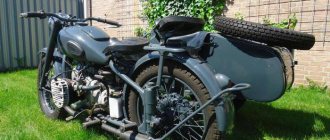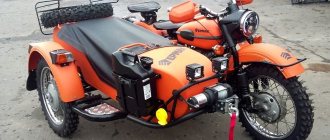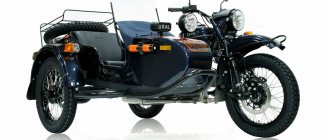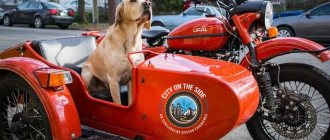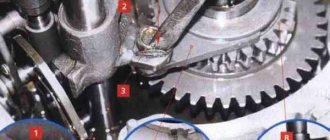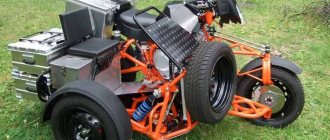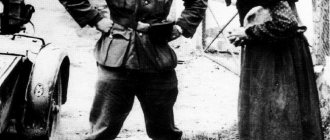The production volume at IMZ has decreased 110 times over the past twenty years - from 130 thousand motorcycles in 1992 to 1.2 thousand in 2012. The status of a world giant is irretrievably lost. According to many Russians, the IMZ has been ordered to live for a long time: when was the last time you saw a new Ural on the street? Meanwhile, in the early 2000s, the plant relied on exports; today it has one and a half hundred dealers in the USA, Canada, Europe, Australia and other countries. The plant, which was on the verge of survival, is again making a profit, albeit a small one. Our conversation with the general director and co-owner of IMZ, Ilya Khait, was “virtual”: the head of the Irbit enterprise has been living in Seattle (USA) for ten years, and gave the interview from Taipei (Taiwan), where he is studying local component manufacturers.
Advantage in a stroller
— Ilya, in the 90s you headed a St. Petersburg consulting company. How did you get to IMZ?
— I must say thank you to Kakha Bendukidze. Uralmashplant, which he owned at that time, was one of our clients. At the beginning of 1998, Kakha bought IMZ and asked to go to Irbit to see what the enterprise was like. We worked as consultants for a couple of years, and then it turned out that we bought the plant.
- How so?
“Things were bad at IMZ at that time, and while we were figuring out what to do with it, it became completely sad: the lights were turned off, there was no money for heating. We had to stop production. During the six months that the plant was not operating, we agreed with Bendukidze that we would buy IMZ. Four people took part in the ransom; I cannot name the amount, but it was very large for the state in which the enterprise was.
— What made you buy a dying plant, and at an inflated price?
“I tell everyone that I feel sorry for the Ural - it shouldn’t have died. In fact, there was a reason: the plant in Tmutarakan is unclear how it sells motorcycles abroad, despite the terrible quality and the wild situation at the enterprise. Let's add to this healthy or unhealthy adventurism. We didn't have a clear business plan at the time of the deal, but it was cool. This is the interesting part. The sad thing is that the plant was dying.
— But did you have an idea of what needed to be done?
— When we worked with Kakha, we believed that IMZ should be present on the domestic market. The Wolf motorcycle project appeared, there was good marketing, a lot of noise, but nothing happened. By the time we became owners, we realized that there was nothing to catch on the domestic market. In 2012 in Russia we sold just over forty motorcycles. My then partner Dmitry Lebedinsky formulated the idea that we need to focus on exports, and this saved us. We understood why Urals are bought abroad: the reason is not that our motorcycle was perceived as a time machine, although that was the case. The main thing is that it has functionality that is interesting to foreign consumers: it is not just a motorcycle with a sidecar, but with a drive to the sidecar wheel, that is, a jeep among motorcycles. This turned out to be an important moment of self-awareness.
The Americans pointed out the advantages of the Ural motorcycle
An article by the American information portal Cycle World also talks about the extraordinary practicality of the Russian-made Ural motorcycle, which is capable of traveling off-road.
“It has enough space for all family members and even a week’s supply of food,” the author of the material admired.
In addition, the Americans liked the presence of a reverse gear on the Ural motorcycle. They believe it would be incredibly convenient on a range of two-wheeler models as well.
I change three for four
— At what point did Irbit motorcycles stop being in demand in Russia?
— In 1992, IMZ produced almost 131 thousand motorcycles, and in 1997 - four thousand. Within five years the domestic market disappeared. This happened because people started buying cars, the need for a motorcycle as a means of transportation disappeared. It was impossible to do anything about this. They often point fingers at us and say “they destroyed the plant.” Then we have to remind this story. Another thing is that in the 90s management could work more energetically in the sense that volumes fell significantly, but the size of the plant did not change.
— Why did Uralmashplant need IMZ?
— It was the beginning of 98, everything was bought up. The one who sold it painted a beautiful picture; if I’m not mistaken, the figure was that the plant would sell 20 thousand single motorcycles a year. There was also an idea that IMZ, which produces consumer goods, would help shape the positive image of the United Machine-Building Plants holding, which was created by Kakha Bendukidze.
— As a result, you turned out to be the owner of the enterprise, which experienced a hundredfold drop in production.
- Well, yes. And I think that the plant was lucky with both the owners and those plant managers who did not jump ship, but continued to fight with us for survivability. In 1992, the plant was the largest in Europe. The 1.2 thousand that we made in 2012 is the two-day volume of work for such a plant. I don’t know of examples, either in our industry or in any other industry, when companies remained afloat after such a reduction.
From evacuation to globalization
— Judging by your website, the price of a Ural now starts at 10 thousand dollars. Previously it cost ten times less.
— One of our key tasks was to make a normal product. We have preserved the historical appearance of the Ural, but inside it is a completely different motorcycle. 60% of its value today comes from imported components; essentially, only metal remains domestic. The suspension, braking system, electronics, wheels - everything had to be changed, because domestic components are simply a disaster. The generator, which was produced by the Moscow Automotive Equipment Plant, broke down on 20 motorcycles out of a hundred during the first year. Now we use Japanese Denso generators. The ignition was done by the Yekaterinburg NPO Automation - they also started with a 20% failure rate. We persuaded them and threatened to leave. They didn’t believe us, the quality was gradually getting better, but not fundamentally. In the end, we gave up: now we buy the ignition in Italy, it does not fail. And so with everything. The situation only got worse because the industry was dying. Today in Russia nothing normal is produced for the motorcycle industry, not even signal lights. We started buying components in Europe, Japan, the USA, and in recent years we have been developing the Asian market, primarily Taiwan.
Plus, the price of a motorcycle has increased, because in Russia everything has gone up in price insanely and absolutely unreasonably, from labor to electricity and gas. Russia is now practically one of the most expensive countries in the world for any production.
— But 10 thousand dollars is not too much?
— This is the normal price for a motorcycle with a sidecar. We remain the only plant in the world that produces them at the factory. Previously, they were produced by the Kiev Motorcycle Plant, the Chinese Chang Jiang, Izhmash and the Czech Jawa. There are several dozen stroller manufacturers in Europe and America. Until the year before last, Harley Davidson made them a little, but sold them as an accessory. So if a person needs such a motorcycle, there is only one alternative - buy a regular two-wheeler, buy it separately, or make a stroller yourself. But the combination will ultimately cost more than the Ural. But a motorcycle with a sidecar wheel drive cannot be made at all.
Motorcycle is a hobby. Yes, it costs like a budget car, and that's fine. Of course, if we sold the Ural for three thousand dollars, it would be in great demand, but we cannot make a high-quality motorcycle for that kind of money.
— Are you satisfied with the build quality now?
- No, although it is much better than it was. This is one of the reasons why we are increasing the share of foreign components. There are a bunch of problems here. We have a small production facility, we won’t be able to update our machining equipment, and not at all because we don’t want to. Let me give an example of bevel gears for reverse gear. A new set of CNC machines with control equipment from Gleason costs approximately $3.5 million. He will make one of our gears in eight minutes, and he will shovel our entire annual program in two or three weeks. We will never pay for such a complex, and the existing equipment will sooner or later fail. And this is the case with almost all engine and transmission parts. Therefore, we are forced to specialize the site in Irbit in certain technological processes and operations. Most likely, the bulk of mechanical processing from Irbit will be outsourced, leaving welding, body fabrication, painting, assembly and machining to a minimum.
— In this situation, the essence of the site in Irbit is not lost?
- This is a killer question. Kakha at one time terrorized the IMZ management with them: “Why is the plant in Irbit?” Unfortunately, the only correct answer is that Irbit is beyond the reach of German bombers: in 1941, the plant was evacuated here from Moscow. All. From a logistics point of view, this is a complete nightmare, the city is small, the staff seems to be inexpensive, but their qualifications leave much to be desired, etc. Of course, the plant is not in place. True, there is a subtlety: in the motorcycle world it is difficult to sell something without a story. People want a motorcycle to have some intangible component. In this sense, it is important to have production in Irbit.
Site archive
Photo: RIA Novosti/Igor Mikhalev
The $18,000 Ural Sahara motorcycle entered the top 10 luxury passenger vehicles according to Bloomberg. The list was topped by the Lamborghini Huracán Spyder, which costs $262.35 thousand in the US.
A motorcycle with a leading sidecar, the Ural Sahara (in the USA 2021 Ural Sahara Gear Up), produced by the Irbit Motorcycle Plant, entered the top of the best luxury vehicles of 2021 according to Bloomberg. The starting price for the motorcycle that took fifth place in the ranking is $18 thousand in the United States.
The motorcycle is equipped with a four-stroke boxer engine producing 41 horsepower and is equipped with a three-speed gearbox. In addition to the stroller, the basic package includes a spare wheel, a luggage rack, a black ten-liter canister, a shovel, a set of tools and a removable side panel for charging your phone.
By paying an additional $2 thousand, the motorcycle can be equipped with an “off-road kit”: a GIVI brand windshield, LED headlights and fog lights with grille, additional compartments for carrying things and a 12-volt adapter. The maximum speed of the motorcycle is about 110 km. Black ceramic-coated exhaust pipes and Heidenau K37 mud tires are also available for an additional cost.
BMW and Ducati also presented updated and interesting motorcycles, but the peculiarity of the Ural Sahara is that it can be ridden on any road at any time of the year. This is an ideal motorcycle for hunting and fishing, notes Bloomberg.
Entering the US market
Ural motorcycles are produced by the Irbit Motorcycle Plant, founded in 1941. At the end of February 1942, the first batch of M-72 motorcycles was produced, which were used by the Soviet army during the Second World War. In total, during the war years, about 10 thousand motorcycles were sent to the front from the plant.
The most difficult year for IMZ turned out to be 2000, when the company was cut off heat and electricity for debts. Production was stopped. At the same time, four top managers of the plant - Vadim Tryapichkin, Ilya Khait, Dmitry Lebedinsky and Vladimir Yudin offered to buy out IMZ. The deal was closed in 2001.
In 2015, IMZ produced just over 1.2 thousand motorcycles. Most of the parts are imported. The largest number of motorcycles were sold in the USA and Western Europe, sales in the USA are carried out by Irbit MotorWorks of America. The controlling shareholder of the plant is Ilya Khait.
The Ural brand is known among motorcycle enthusiasts all over the world. In the West, they are especially valued for having a powered stroller. In Europe and the USA there are clubs for fans of Irbit motorcycles. Crown Prince Abdala of Jordan owns three Urals, Kompaniya magazine previously wrote.
Cars list
The list of the best luxury passenger vehicles according to Bloomberg is topped by the Lamborghini Huracán Spyder, which costs $262.35 thousand in the United States. In second place is the Bentley Flying Spur S. Two models of this car are available in the United States: Flying Spur W12 S for $244 ,6 thousand and Flying Spur V8 S for $205 thousand. The top three was closed by the McLaren 570GT with a starting price of about $199 thousand.
In fourth place is the Rolls-Royce Dawn (from $340 thousand). Next on the list: Ural Sahara Gear Up (from $18 thousand); BMW M2 (from $51.7 thousand); Ferrari California T (from $199 thousand); Aston Martin Vantage GTS (from $137.8 thousand); Volvo S90 (from $47 thousand) and Porsche Panamera (from $100 thousand).
And Pitt at the Ural
— The lack of quality did not prevent the Urals from creating a history for themselves in the USA in the 90s.
— On this basis, a community of Ural owners grew in the States, because they needed to exchange ideas on how to repair it. It is still developing and is an integral part of our company. An American started exporting motorcycles to the USA: in 1993, he came to Russia, saw a Ural on the street, caught fire and decided to get into it. The merits of this first dealer in improving quality are enormous. He sent specialists to the plant at his own expense, taught how to paint (the Americans, when they received a motorcycle, first of all stripped off the factory coating), do pre-sale preparation, etc. If there were no external market, the motorcycle would remain the way it was. True, when we became the owners of IMZ and decided to independently develop sales, we even had to sue this person over the trademark.
— How many dealers does Ural have now?
— In the USA — 72, in Europe — more than 60, in Canada — 12, in Australia — eight. The majority of companies are professional motorcycle dealers. The sales system is the same as everyone else’s: the same dealers sell BMW, Suzuki, Kawasaki and other brands. For example, 10% of American BMW dealers deal in Urals. Some time ago we worked with small companies, as they say in the States, cottage type - barn dealers. There are almost no such people left, only the most experienced ones who know the business very well and sell well.
— Is this the result of your work?
— Three years ago, we hired an expensive, but very high-quality specialist who had worked in large companies before us. We pay him a lot of money, he gives results.
— Why the emphasis on the USA?
— This is a large country, more than 300 million people, vast distances, developed motorcycle traditions and high solvency. Plus, people here are not as conservative as, say, in Europe, they are open to new things. In this sense, America is similar to Russia. This is probably why “Ural” took root.
— How did you end up in the States?
— In 2002, it became clear that working through independent importers did not suit us; we needed to take control of international distribution. They divided the whole world between partners, one of us went to organize a sales system in Europe, and I was sent to organize distribution in America. Well, and then... The head of a company with such a geography sooner or later has to decide where to be - where is the main income or the main expenses.
— Is Ural in demand among Russians in the States?
“When our people leave somewhere, they begin to deny everything connected with their former homeland. For them, Ural is complete crap. They wonder why Americans buy them.
— At the beginning of last year, there was a lot of news in the media that Brad Pitt bought Ural. Did you have a hand?
- Of course not. It was a funny situation. The dealer calls: “I think I sold a motorcycle to Brad Pitt. It was bought by representatives of such and such a company, we checked it on the Internet, it deals with the actor’s affairs.” We ask, where are the photographs? Dealer: “We asked people who bought. They said that you don’t have to worry about it, in a couple of days the paparazzi will take pictures of it somewhere.” And so it happened: Brad Pitt was caught in the Ural with a child near a bakery. We were in all the world and Russian media then.
— Do you actually have an advertising budget?
- If I voiced it, you would cry... Or laugh. In terms of advertising dollars spent per motorcycle, we probably have the lowest ratio in the entire motorcycle industry. And it’s not that we don’t have money for large-scale marketing. The channels for conveying information to the buyer have changed. The rise of the internet has revolutionized marketing, especially for small companies with a niche product like us. Since the beginning of 2009, we have basically stopped using traditional channels like print publications, exhibitions and other things, and began to engage in, I would say, virtual social marketing.
— According to your forecasts, how many motorcycles will IMZ sell, for example, in 2021?
— You won’t believe it, but I don’t know: the situation in the industry is changing very quickly. The last three years we have been growing by 30%, if the pace continues, then in 2020 we will sell about 10 thousand motorcycles. And if the rate is 10%, then about 3 thousand.
— What tools for increasing sales will be given more attention?
— As for the States, increasing the dealer network, because a huge territory is not yet covered. People have to travel far to see a motorcycle. We need to help dealers buy our products: the industry has a financial instrument that allows them to raise borrowed funds against our guarantees. It is necessary to improve the basis for working with customers - these are new catalogs, technical manuals, etc. Ural owners love things like changing the oil themselves and adjusting valves, and we must help them with this. Also, unlike lovers of all other brands, ours spend an order of magnitude more time preparing for the purchase. When a buyer comes to a dealer, the most important thing for us is that the seller knows more about the product, otherwise there will be no trust. That is, you need to spend more effort on learning. Plus, we will introduce various non-standard marketing tools aimed at attracting new people from the current owners.
— Which markets seem promising?
- Asia definitely. We are late as always, since all the producers are already here, but I think there is a little room left for us.
— What about the CIS, Russia?
— The CIS countries are poor. Russia - yes, and we will make some efforts this year to sell more here. Until recently, it was generally possible to buy a new motorcycle in our country only at the factory. This year we entered into a distribution agreement with St. Petersburg. Their main task is to develop a sales and service system. It is a utopia to expect that in Russia there will someday be a demand for 130 thousand motorcycles, as before. The number of people who can afford such a hobby is small, and the season, given the climate, is short. However, we think that we have potential in Russia, and the time has come to get more serious about the domestic market.


